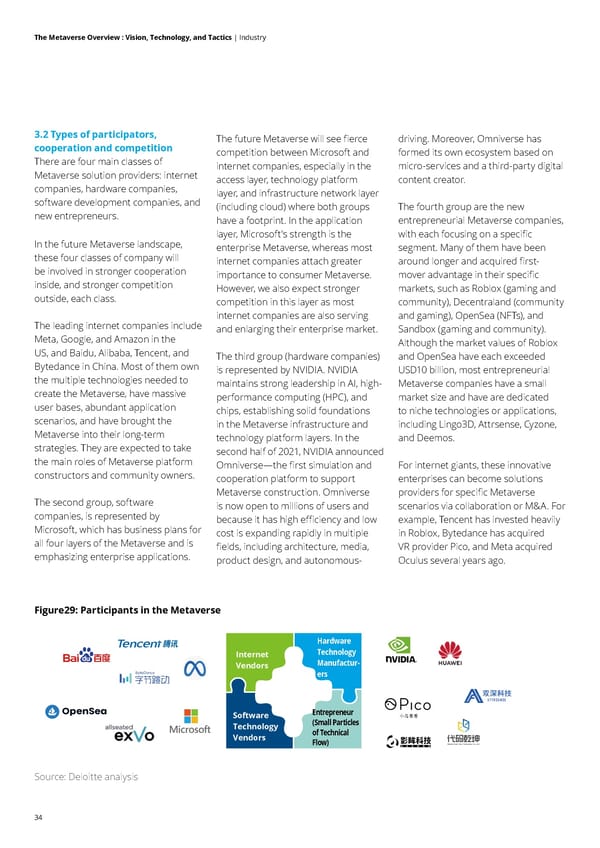34 The Metaverse Overview : Vision, Technology, and Tactics | Industry 3.2 Types of participators, cooperation and competition There are four main classes of Metaverse solution providers: internet companies, hardware companies, software development companies, and new entrepreneurs. In the future Metaverse landscape, these four classes of company will be involved in stronger cooperation inside, and stronger competition outside, each class. The leading internet companies include Meta, Google, and Amazon in the US, and Baidu, Alibaba, Tencent, and Bytedance in China. Most of them own the multiple technologies needed to create the Metaverse, have massive user bases, abundant application scenarios, and have brought the Metaverse into their long-term strategies. They are expected to take the main roles of Metaverse platform constructors and community owners. The second group, software companies, is represented by Microsoft, which has business plans for all four layers of the Metaverse and is emphasizing enterprise applications. The future Metaverse will see fierce competition between Microsoft and internet companies, especially in the access layer, technology platform layer, and infrastructure network layer (including cloud) where both groups have a footprint. In the application layer, Microsoft's strength is the enterprise Metaverse, whereas most internet companies attach greater importance to consumer Metaverse. However, we also expect stronger competition in this layer as most internet companies are also serving and enlarging their enterprise market. The third group (hardware companies) is represented by NVIDIA. NVIDIA maintains strong leadership in AI, high- performance computing (HPC), and chips, establishing solid foundations in the Metaverse infrastructure and technology platform layers. In the second half of 2021, NVIDIA announced Omniverse—the first simulation and cooperation platform to support Metaverse construction. Omniverse is now open to millions of users and because it has high efficiency and low cost is expanding rapidly in multiple fields, including architecture, media, product design, and autonomous- driving. Moreover, Omniverse has formed its own ecosystem based on micro-services and a third-party digital content creator. The fourth group are the new entrepreneurial Metaverse companies, with each focusing on a specific segment. Many of them have been around longer and acquired first- mover advantage in their specific markets, such as Roblox (gaming and community), Decentraland (community and gaming), OpenSea (NFTs), and Sandbox (gaming and community). Although the market values of Roblox and OpenSea have each exceeded USD10 billion, most entrepreneurial Metaverse companies have a small market size and have are dedicated to niche technologies or applications, including Lingo3D, Attrsense, Cyzone, and Deemos. For internet giants, these innovative enterprises can become solutions providers for specific Metaverse scenarios via collaboration or M&A. For example, Tencent has invested heavily in Roblox, Bytedance has acquired VR provider Pico, and Meta acquired Oculus several years ago. Figure29: Participants in the Metaverse Source: Deloitte analysis 小鸟看看 Internet Vendors Hardware Technology Manufactur- ers Software Technology Vendors Entrepreneur (Small Particles of Technical Flow)
 Deloitte The Metaverse Overview Page 33 Page 35
Deloitte The Metaverse Overview Page 33 Page 35